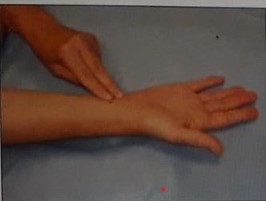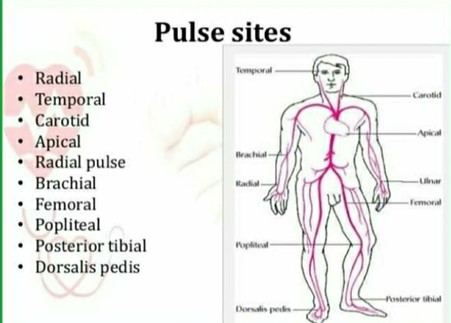The practical nurse (PN) observes a newly hired unlicensed assistive personnel (UAP) who is counting a client's radial pulse as seen in the picture. Which action should the PN take?

Instruct the UAP to report any abnormal findings.
Remind the UAP to check the client's pulse volume
Demonstrate the correct pulse site to the UAP
Confirm the accuracy of the pulse rate obtained by the UAP
The Correct Answer is C
- A radial pulse is the pulse felt at the wrist, where the radial artery runs along the thumb side of the forearm. It is one of the most common sites for measuring a person's heart rate.
- To measure a radial pulse, the examiner should place two or three fingers over the radial artery, just below the wrist crease, and apply gentle pressure until a pulsation is felt. The examiner should not use the thumb, as it has its own pulse and may interfere with the accuracy of the measurement. The examiner should count the number of beats for 15, 30, or 60 seconds, depending on the regularity and rate of the pulse.
- In the picture, the unlicensed assistive personnel (UAP) is using the thumb to measure the radial pulse, which is incorrect. The practical nurse (PN) should demonstrate the correct pulse site to the UAP and explain why using the thumb is not appropriate. This will help to ensure that the UAP obtains an accurate and reliable pulse rate for the client.
Therefore, option C is the correct answer, while options A, B, and D are incorrect.
Option A is incorrect because instructing the UAP to report any abnormal findings does not address the error in technique.
Option B is incorrect because reminding the UAP to check the pulse volume does not address the error in technique.
Option D is incorrect because confirming the accuracy of the pulse rate obtained by the UAP does not address the error in technique.

Nursing Test Bank
Naxlex Comprehensive Predictor Exams
Related Questions
Correct Answer is D
Explanation
The correct answer is D. Activate the lockdown procedure.
Choice A rationale:
Asking the mother about expected visitors is important for later investigation, but it does not address the immediate concern of a potentially missing infant and delays necessary security measures.
Choice B rationale:
Matching ID bands is an essential step in verifying the identity of infants and mothers, but it should follow initial actions to secure the area and prevent possible abduction.
Choice C rationale:
Determining if the newborn is in the nursery is a logical step but not the first priority. The immediate action should be to secure the unit to prevent any potential abductor from leaving.
Choice D rationale:
Activating the lockdown procedure is the first priority to ensure the safety of the infant and prevent any unauthorized individuals from leaving the facility. This step is crucial to quickly address the situation and prevent potential abduction.
Correct Answer is C
Explanation
The correct answer is Choice C: Assign the remainder of medication administration to another PN who is performing treatments.
Choice A rationale: Denying the medication aide's request to leave before all medications are given does not address the issue at hand and could potentially jeopardize patient care. It is important to acknowledge the medication aide's request and find an appropriate solution that ensures patient safety and well-being.
Choice B rationale: Delegating medication administration to unlicensed assistive personnel (UAP) who may not have the necessary training or authorization could lead to medication errors, adverse drug reactions, or other negative outcomes. It is essential to adhere to the scope of practice guidelines and facility policies when assigning tasks to UAPs.
Choice C rationale: Reassigning the medication administration to another PN with the necessary qualifications and training ensures that patients receive their medications in a safe and timely manner. This action aligns with the practical nurse's responsibility to supervise and delegate tasks appropriately, maintaining patient safety and upholding the standards of care.
Choice D rationale: Documenting why medications were not given to each resident is an important aspect of maintaining accurate and comprehensive patient records. However, it does not address the immediate need to administer medications to residents, and it is not a substitute for ensuring that patients receive their prescribed treatments. Documentation should be completed after the appropriate steps have been taken to administer medications or arrange for an alternative solution.
Whether you are a student looking to ace your exams or a practicing nurse seeking to enhance your expertise , our nursing education contents will empower you with the confidence and competence to make a difference in the lives of patients and become a respected leader in the healthcare field.
Visit Naxlex, invest in your future and unlock endless possibilities with our unparalleled nursing education contents today
Report Wrong Answer on the Current Question
Do you disagree with the answer? If yes, what is your expected answer? Explain.
Kindly be descriptive with the issue you are facing.
